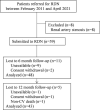Favorable effect of renal denervation on elevated renal vascular resistance in patients with resistant hypertension and type 2 diabetes mellitus
- PMID: 36601066
- PMCID: PMC9806766
- DOI: 10.3389/fcvm.2022.1010546
Favorable effect of renal denervation on elevated renal vascular resistance in patients with resistant hypertension and type 2 diabetes mellitus
Abstract
Objective: To assess the effect of renal denervation (RDN) on renal vascular resistance and renal function in patients with drug-resistant hypertension (HTN) and type 2 diabetes mellitus (T2DM).
Materials and methods: Fifty-nine patients (mean age 60.3 ± 7.9 years, 25 men) with resistant HTN [mean 24-h ambulatory blood pressure (BP) 158.0 ± 16.3/82.5 ± 12.7 mmHg, systolic/diastolic] and T2DM (mean HbA1c 7.5 ± 1.5%) were included in the single-arm prospective study and underwent RDN. Renal resistive index (RRI) derived from ultrasound Doppler; estimated glomerular filtration rate (Chronic Kidney Disease Epidemiology Collaboration formula), office and 24-h ambulatory BP were measured at baseline, 6, and 12 months after RDN to evaluate the respective changes in renal vascular resistance, renal function, and BP during treatment.
Results: Forty-three patients completed 12 months follow-up. The RRI changed depending on the baseline value. Specifically, the RRI decreased significantly in patients with elevated baseline RRI values ≥ 0.7 {n = 23; -0.024 [95% confidence interval (CI): -0.046, -0.002], p = 0.035} and did not change in those with baseline RRI < 0.7 [n = 36; 0.024 (95% CI: -0.002, 0.050), p = 0.069]. No significant change was observed in eGFR whereas BP was significantly reduced at 12 months after RDN by -10.9 (95% CI: -16.7, -5.0)/-5.5 (95% CI: -8.7, -2.4) mmHg, systolic/diastolic. No relationship was found between the changes in RRI and BP.
Conclusion: Our study shows that RDN can decrease elevated renal vascular resistance (RRI > 0.7) and stabilize kidney function in patients with RHTN and T2DM independently of its BP-lowering effect.
Keywords: renal denervation; renal function; renal hemodynamics; renal resistive index; resistant hypertension; type 2 diabetes mellitus.
Copyright © 2022 Manukyan, Falkovskaya, Mordovin, Pekarskiy, Zyubanova, Solonskaya, Ryabova, Khunkhinova, Vtorushina and Popov.
Conflict of interest statement
The authors declare that the research was conducted in the absence of any commercial or financial relationships that could be construed as a potential conflict of interest.
Figures




References
-
- Di Nicolò P, Prencipe M, Lentini P, Granata A. Intraparenchymal Renal Resistive Index: The Basic of Interpretation and Common Misconceptions. In: Granata A, Bertolotto M. editors. Imaging in Nephrology. Cham: Springer International Publishing; (2021). 147–56. 10.1007/978-3-030-60794-4_13 - DOI
LinkOut - more resources
Full Text Sources
Research Materials
Miscellaneous

